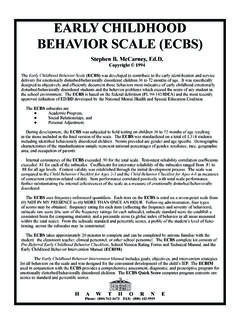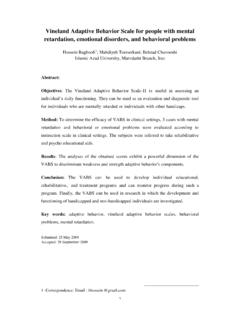Transcription of ADAPTIVE BEHAVIOR EVALUATION SCALE REVISED SECOND …
1 H A W T H O R N EPhone: (800) 542-1673 FAX: (800) 442-9509 ADAPTIVE BEHAVIOR EVALUATION SCALEREVISED SECOND EDITION: 4-12 YEARS(ABES-R2: 4-12 Years) Stephen B. McCarney, & Tamara J. Arthaud, Copyright 2006 The ADAPTIVE BEHAVIOR EVALUATION SCALE - REVISED SECOND Edition (ABES-R2) provides a measure of ADAPTIVE skills nec-essary for success in educational and residential settings. The ABES-R2 may be used as a general or specific measure of ADAPTIVE skills with any student experiencing academic or behavioral difficulties regardless of the severity or suspected disability.
2 The ABES-R2 assesses 10 areas of ADAPTIVE skills grouped under the three ADAPTIVE BEHAVIOR domains defined in the 10th AAMR Definition of Mental Retardation (AAMR, 2002). The Conceptual domain assesses the ADAPTIVE skills areas of Communication and Functional Academics. The Social domain assesses the Social, Leisure, and Self-Direction ADAPTIVE skills areas. Self-Care, Home Living, Community Use, Health & Safety, and Work are the ADAPTIVE skills areas assessed in the Practical ABES-R2:4-12 School Version was standardized on a total of 3,288 students.
3 The ABES-R2: 4-12 Home Version was standardized on a total of 1,998 students. Demographic characteristics of the standardization population approximated the national percentages for gender, residence, race, geographic area, and occupation of consistency of the ABES-R2: 4-12 School Version fell at or above .85 for each subscale. Test-retest reliability yielded correlation coefficients ranging from .61 to .78, indicating substantial reliability for each of the 10 subscales. Coef-ficients for inter-rater reliability for the subscales ranged from.
4 60 to .80 for all age levels. Content validity was established through the initial development process. The SCALE was compared to the vineland ADAPTIVE BEHAVIOR Scales-Classroom Edi-tion (1985) and ADAPTIVE BEHAVIOR SCALE - School: SECOND Edition (1993) as a measure of concurrent validity. The construct validity of the SCALE supports strong diagnostic validity. Item performance correlated positively with total score performance, further substantiating the internal cohesiveness of the SCALE as a measure of ADAPTIVE ABES-R2: 4-12 uses frequency-referenced quantifiers.
5 Each item on the ABES-R2: 4-12 is rated on a six point SCALE from (0) NOT DEVELOPMENTALLY APPROPRIATE FOR AGE to (5) DEMONSTRATES THE BEHAVIOR OR SKILL CONSISTENTLY. Following administration, seven types of scores may be obtained: frequency rating for each item (reflect-ing the degree of success in performing a BEHAVIOR ), subscale raw score (the sum of the frequency ratings for each subscale), subscale standard score (a consistent basis for comparing students), a domain quotient and percentile, and an ADAPTIVE skills quotient and percentile.
6 Using the subscale standard scores, a profile of the student s level of functioning across the 10 sub-scales may be ABES-R2: 4-12 takes approximately 20 minutes to complete and can be completed by anyone familiar with the stu-dent: the classroom teacher, clinical personnel, other school personnel, or the parent/guardian. The ABES-R2: 4-12 com-plete kit consists of school and home version rating forms and technical manuals, and the ADAPTIVE BEHAVIOR Intervention Manual: 4-12 Years. The intervention manual includes goals, objectives, and intervention strategies for the behaviors on the SCALE and was designed for the convenient development of the student s IEP.
7 The ABES-R2: 4-12 is a valuable tool designed to assist school personnel in making diagnostic, placement, and program-ming decisions for mentally retarded and emotionally disturbed/behaviorally disordered children and adolescents. The strong correlation of school and home ratings of ADAPTIVE skills makes the ABES-R2: 4-12 an efficient and effective means of mea-suring ADAPTIVE skills for educational decision-making. The companion ADAPTIVE BEHAVIOR Intervention Manual: 4-12 Years is a must for use in program development and implementation for handicapped students.
8 The ABES-R2: 4-12 Quick Score is a Windows -compatible program which converts raw scores to standard and percentile The student should be rated by educational person-nel with primary observational opportunities who work directly with the student during instructional situations. If a rater has no knowledge of the student s ability to perform a particular item on the SCALE , it is recom-mended that another educator be consulted to provide information for that item. No boxes are to be left blank. The rater should rely on his/her observation of the stu-dent s BEHAVIOR as it occurs naturally in the educational environment.
9 It is recommended that the rater read each quantifier with the item, before rating the item. Using item 8 as an example, the rater would first read, Is not developmen-tally appropriate for age to tie or fasten shoes, then Does not demonstrate tying or fastening shoes, Is developing tying or fastening shoes, Demonstrates tying or fastening shoes inconsistently, Demonstrates tying or fastening shoes most of the time, and finally Demonstrates tying or fastening shoes consistently. It is not necessary to complete the rating for a student in one day.
10 Several days may elapse before the rater is able to complete the SCALE . The ABES-R2 is not a test which requires a performance demonstration for each item on the SCALE . The rater should rely on observations of the student s ability to perform the behaviors on the SCALE as those behaviors occur naturally in the educational environment. If the BEHAVIOR or skill is developmentally beyond what is expected for the student s age, the rating should be NOT DEVELOPMENTALLY APPROPRIATE FOR AGE. If the student has not yet developed the BEHAVIOR or skill or chooses not to demonstrate the BEHAVIOR or skill, the rating should beDOES NOT DEMONSTRATE THE BEHAVIOR OR SKILL.













